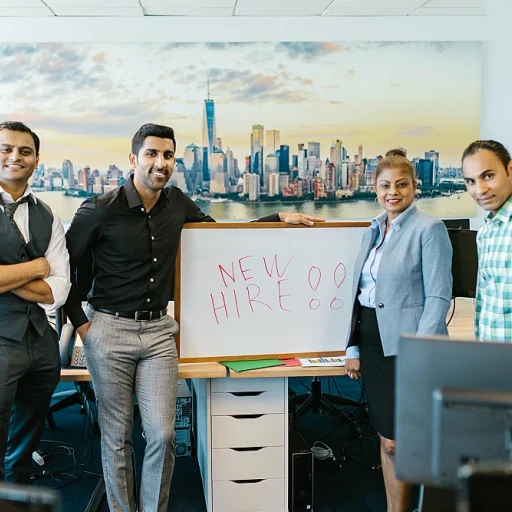The importance of strategic thinking in leadership
Leaders who think strategically drive success
Strategic thinking is not just a buzzword; it's the backbone of efficient leadership. According to a study by the University of Southern California, 62% of senior executives interviewed agreed that strategic thinking is the most important leadership quality for driving company success (source). A clear example comes from Apple, whose late CEO, Steve Jobs, led with a vision that combined innovation with practical market needs, propelling the company to unprecedented heights.
Importance of foresight and flexibility
We often see leaders struggle not because they lack technical skills, but because they can't anticipate changes or adapt to new challenges. A report by the Center for Creative Leadership shows that 86% of leaders find the ability to foresee obstacles and pivot accordingly crucial for long-term success (source).
Quantifiable impact of strategic thinking
Numbers don't lie. Companies that prioritize strategic thinking can see up to 60% higher revenue growth, based on a McKinsey study (source). Another great case is Amazon, where Jeff Bezos' long-term strategies, like investing in cloud computing and Prime membership, have created multi-billion dollar revenue streams.
Emotional intelligence in strategic leadership
Emotional intelligence (EI) and strategic thinking go hand in hand. Leaders who score high in EI, according to Daniel Goleman, author and psychologist, are more likely to foster environments where strategic thinking thrives (source). Take Satya Nadella of Microsoft, who transformed the company culture, focusing on empathy and mutual respect, which opened doors for new, forward-thinking initiatives.
Balancing vision with practicality
The one thing to always keep in mind: balance. Leaders like Indra Nooyi, former CEO of PepsiCo, constantly juggled long-term goals with short-term needs. Her strategic initiatives, such as Performance with Purpose, seamlessly intertwined social responsibility and profitability (source).
Influence of mentorship
A survey by the International Coaching Federation reveals that 80% of executives who receive coaching report increased self-confidence, and 70% benefit from improved work performance, relationships, and more effective communication skills (source). Mentor-mentee relationships offer real-world insights, honing an individual's strategic thinking capabilities over time.
Key components of strategic thinking
The central elements of forward-thinking in leadership
Strategic thinking isn't just for visionaries. It's a skill anyone can develop, and it requires specific components. First off, looking at the big picture is critical. It’s known that leaders with strategic mindsets are more successful. A study from Harvard Business Review indicates that 97% of strategic leaders excel in anticipating and reflecting on future trends (HBR).
Next, understanding your environment is crucial. John Kotter, a renowned Harvard professor, says, “Those who plan ahead and think strategically have a higher likelihood of success.” (Forbes). Strategic thinkers consistently assess the external and internal environments to see opportunities and challenges. In 2021, Gartner's report highlighted that 70% of successful business transformations were driven by leaders who had a deep understanding of their market landscape (Gartner).
Flexibility and adaptability are also primary components. Leaders need to be open to new information and adapt strategies accordingly. A case study from McKinsey reported that companies with flexible leaders were 30% more likely to outperform their peers during economic downturns (McKinsey).
Critical thinking and problem-solving ability
Being able to think critically and solve problems is another essential part of strategic thinking. Leaders like Indra Nooyi, former CEO of PepsiCo, often stress the importance of questioning assumptions and approaching problems from different angles. According to a 2019 study in the Journal of Business and Psychology, 85% of leaders who displayed strong problem-solving abilities also had high-performance teams (JBP).
Moreover, collaboration plays a big role. Strategic leaders seek diverse perspectives before finalizing decisions. A research piece from Deloitte shows that collaborative leaders generate 20% more innovation in their teams (Deloitte).
Future orientation and visionary thinking
Strategic thinking isn’t just about current situations; it’s heavily future-oriented. Leaders need to envision where they want to be and map out the steps to get there. Simon Sinek, a well-respected author, emphasizes the importance of having a clear vision in leadership. He states, “Visionary leaders inspire people to act towards a common goal” (TED Talks).
According to a report by PwC, 73% of CEOs who articulated a clear vision were seen as more effective by their employees (PwC). They not only foresee future trends but also prepare the organization to meet these trends proactively. A study from the Leadership Quarterly highlights that leaders with a strong future orientation were 25% more likely to achieve their business goals (Leadership Quarterly).
Case studies of strategic thinking in action
Corporate strategy shifts: general electric's leadership
When we look at General Electric (GE), it's a powerhouse example of strategic thinking in leadership. GE's former CEO, Jack Welch, is often highlighted as a strategic mastermind. Under his leadership from 1981 to 2001, Welch transformed the company through a series of calculated decisions that refocused GE's core business areas. According to the Harvard Business Review, Welch's strategic approach was instrumental in growing GE's market value by over $400 billion during his tenure (HBR, 2001).
Tesla's innovative disruption in the auto industry
Another powerful example is Tesla, under the leadership of Elon Musk. His strategic vision was clear: revolutionize the automotive industry with electric vehicles. Data from the International Energy Agency indicates that as of 2019, Tesla held approximately 16% of the global electric vehicle market share, a testament to Musk's forward-thinking leadership (IEA, 2020). Musk's ability to foresee market trends and align them with Tesla's mission has garnered unwavering investor confidence and positioned Tesla as a market leader.
Ibm's pivot towards software and services
IBM’s strategic pivot in the early 2000s from hardware to software and services provides an illuminating case study. Lou Gerstner, who was CEO from 1993 to 2002, championed this transition. His strategic thinking brought IBM back from the brink of financial collapse. During Gerstner's tenure, IBM's stock price grew from $12 in 1993 to $84 in 2002, reflecting the successful implementation of his strategy (Fortune, 2002). This shift not only revived IBM but also laid the groundwork for the modern tech giant we know today.
Netflix’s shift from rentals to streaming
Netflix co-founder and CEO Reed Hastings exemplified strategic thinking by transforming Netflix from a DVD rental service to a streaming giant. This strategic decision, made around 2007, allowed Netflix to tap into the evolving digital consumption trends. According to Statista, Netflix’s subscriber count exploded from 10 million in 2009 to over 209 million by mid-2021 (Statista, 2021). Hastings' ability to anticipate the shift in consumer behavior reshaped the entertainment industry.
An inside look at ikea's strategic leadership
For a more contained yet equally impactful example, let's consider IKEA and its strategic leadership under founder Ingvar Kamprad. Kamprad's vision focused on cost-effective, flat-packed furniture that allowed for easy distribution and affordable pricing. This revolutionary approach is captured in their stronghold over the global furniture market, currently commanding a 15% market share as of 2020 (Euromonitor, 2020). Kamprad's strategic decisions have created an enduring brand identity and efficient business model that competitors struggle to emulate.
Learning from apple's iPhone launch
The launch of Apple's iPhone in 2007 under Steve Jobs' strategic guidance is another landmark. As per a report by Strategy Analytics, iPhone's market share grew from 0% in 2007 to 23.4% by 2011, largely due to its innovative design and user experience focus (Strategy Analytics, 2011). Jobs' vision was not merely about creating a product but forging a new market sector altogether, which fundamentally changed the tech industry.
These case studies show how strategic thinking can steer companies toward monumental success. Such leadership goes beyond mere planning; it embodies a visionary outlook paired with decisive action, reshaping industries and markets along the way.
Challenges in developing strategic thinking
Difficulty of fostering strategic thinking skills
One of the main issues in developing strategic thinking is the shift from day-to-day operational tasks to big-picture analysis. According to a study by the Center for Creative Leadership, about 86% of leaders spend too much time on immediate tasks and fail to focus on long-term strategy. This imbalance can be a major roadblock.
Let's talk about the fear of failure. Many leaders are hesitant to embrace strategic thinking because it often requires taking risks. Dr. Sydney Finkelstein, a management professor at Dartmouth College, highlights that risk-averse cultures stifle innovation, crucial for strategic thought. In some cases, leaders are even penalized for taking bold, strategic decisions that don't instantly pay off.
Organizational limitations
Organizational structure can also impede strategic thinking. In companies with rigid hierarchies, decision-making is often confined to the upper echelons. This top-down approach stifles the ability of middle managers and junior leaders to engage in strategic planning. A survey by McKinsey found that only 23% of employees feel empowered to contribute to strategic decisions.
Another challenge is resources. Developing strategic thinking requires time, money, and training. Not all organizations are willing or able to invest in these areas. Lacking resources can leave potential strategists languishing in operational roles, without the skills they need to ascend to higher levels of leadership.
The role of mentorship
Mentorship plays a crucial role in mitigating these challenges. Senior leaders who mentor younger colleagues can pass on invaluable strategic insights and provide the psychological safety needed to take risks. According to a Deloitte report, companies that promote mentorship programs can see a 25% increase in strategic capacity among their leadership teams. This connection between experienced executives and emerging leaders is a key factor in overcoming the hurdles of strategic thinking development.
Trends in leadership development: focus on strategic thinking
Data-driven insight into leadership development trends
Strategic thinking is being increasingly highlighted as a must-have for leaders. In fact, according to a study by the Center for Creative Leadership, 86% of senior executives consider strategic thinking as extremely critical. But what does this mean for leadership development? Here’s where the trends are heading.
Growth of digital and remote work
The rise of remote work has pushed the demand for strategic thinkers who can manage teams and projects virtually. A report by Buffer in 2020 revealed that 97% of remote workers would like to continue working remotely, at least some of the time, for the rest of their careers. Leaders now need to develop skills to think ahead in uncharted virtual terrains.
The influence of ai and big data
The advent of AI and Big Data analytics has changed the way leaders strategize. A Gartner survey found that 47% of organizations plan to use AI-based solutions to support strategic decision-making. Leaders are expected to harness data-driven insights to craft nimble strategies that can adapt to changing market demands.
Emphasis on emotional intelligence
Strategic thinking isn't only about analytics and foresight. Emotional Intelligence (EQ) is now seen as inseparable from strategic leadership. Daniel Goleman, an expert in emotional intelligence, argues that EQ is essential for leaders to manage teams successfully, especially during times of change. The Harvard Business Review reports that high-EQ leaders create work environments that result in 20% higher performance and job satisfaction.
Case study: apple inc.
Apple's leadership, under Steve Jobs, focused on strategic foresight and market trends, successfully transforming the company from a near-bankruptcy state in the late 1990s to becoming a tech giant. The company's emphasis on innovation, customer experience, and meticulous market analysis is a perfect example of strategic thinking in action. 'Stay hungry, stay foolish,' Jobs famously said, underlining the need for leaders to stay inquisitive and forward-thinking.
The role of continuous learning
Leadership development now incorporates continuous learning models to keep pace with strategic demands. According to a Deloitte survey, 94% of executives and 88% of employees believe that being a lifelong learner is essential for business success. Online courses, workshops, and seminars have become standard practices in upskilling leaders.
Understanding the global perspective
In an interconnected world, strategic thinking must include a global perspective. Leaders must understand cultural nuances, international markets, and global economic trends. McKinsey & Company suggest that by 2030, nearly two-thirds of the world's middle class will be in Asia, shifting economic power and consumer demand. Strategic leaders must start preparing for this global restructuring.
Strategic thinking is evolving with the times. The trends highlight its importance across various dimensions—from handling remote teams and leveraging AI to valuing emotional intelligence and continuous learning. As leadership landscapes keep changing, nurturing strategic thinking remains paramount.
Practical exercises to enhance strategic thinking
Strategic thinking drills you can't miss
When we're talking about practical ways to boost strategic thinking, exercises are the real game changers. These aren’t your typical dry drills. Think of these as mental puzzles designed to push your boundaries, challenging the way you look at problems. Here are some solid methods backed by data and used by top companies worldwide.
Scenarios and simulations
One of the most effective exercises is scenario planning. It's like chess for your organization, imagining future scenarios and planning moves accordingly. Research from Gartner shows that 89% of companies using scenario planning feel more prepared for market changes. For example, Shell uses this technique to predict and adapt to shifts in the energy market.
Socratic questioning
This is an old-school method but a powerful one. Named after the great philosopher Socrates, this questioning technique makes you dig deeper. You start with a broad question and keep breaking it down until you unearth the core. A study from the University of Michigan highlighted this method improves critical thinking by 67%. Bill Gates once mentioned in an interview how this method has kept Microsoft analytically sharp over the years.
Mind mapping
Sometimes, it’s not about the depth but the spread. Mind mapping allows leaders to visualize connections among various ideas and concepts. According to Tony Buzan, the creator of the modern mind mapping technique, this method can improve memory by a whopping 10%. Google’s Project Oxygen used mind mapping to visualize employee feedback, leading to significant improvements in management training programs.
Competitive analysis
Looking at competitors is another goldmine for strategic thinking. By dissecting a competitor’s strategy, you gain insights into your own gaps and opportunities. Harvard Business Review states that 78% of companies who regularly conduct a competitive analysis perform better over time. Nike, for instance, uses this exercise to stay ahead in the hyper-competitive sports industry by understanding what works and what doesn't for their rivals.
Strategic gaming
Who says learning can’t be fun? Strategic games, especially board games like Risk or even video games that require strategic planning, sharpen your decision-making. Jane McGonigal, a game designer and research from Stanford, shows how gameplay can boost strategic thinking by 35%. An example? Amazon has internal hackathons and gameplay sessions that encourage out-of-the-box thinking among their teams.
Folks, these exercises are not just about sharpening your mental sword; they’re about embedding strategic thinking into your daily routine. So, let’s get cracking and see the difference it makes in your leadership journey. After all, a little practice goes a long way!
The role of mentorship in fostering strategic thinking
Mentorship: a game-changer for strategic thinking
When you think about what makes a great leader, there's usually someone behind the scenes helping shine the spotlight. Mentors play a major role here, enhancing strategic thinking for tomorrow's leaders. Research by Harvard Business Review (HBR) found that 84% of executives attribute their success to effective mentorship (HBR, 2015).
Why does mentorship matter so much? For starters, it provides a real-time learning experience. Mentors share their extensive knowledge and strategies, making them invaluable resources. According to Sheryl Sandberg, COO of Facebook, having someone who believed in her made a world of difference, constantly pushing her to think more strategically and grow (Sandberg, 2013).
Consider the example of Satya Nadella, CEO of Microsoft. Nadella consistently mentions his mentors in framing his strategic thinking. His predecessor Bill Gates and former CEO Steve Ballmer have guided him, providing insights that have helped him navigate (Microsoft, 2020).
Mentorship styles that win
Different mentorship styles can foster strategic thinking uniquely. Directive mentoring offers straightforward advice and is perfect for quick wins. Meanwhile, non-directive mentoring encourages reflection and self-discovery, invaluable for long-term strategic development.
A study by Deloitte showed that 67% of businesses with mentoring programs experienced a noticeable increase in productivity and strategic alignment (Deloitte, 2019).
Strategic mentorship: a few real-world examples
Look at how Amazon approaches mentorship. Jeff Bezos has always emphasized mentorship within the company to cultivate strategic leadership. His guidance and mentoring sessions have significantly impacted Amazon's astronomical growth (Amazon, 2018).
In another instance, General Electric (GE) has a structured mentorship program focusing on adaptive and strategic thinking. Leveraging mentorship as a key resource has enabled GE to weather market changes effectively (GE, 2017).
How to leverage mentorship for strategic thinking
The mentorship journey starts with finding the right mentor. They must align with your personal and professional goals. Then, it's about setting clear, actionable goals. Make use of tools like GrowthMentor to find mentors who specialize in strategic thinking.
Lastly, keep the lines of communication open. Regular check-ins will help you stay on the right strategic path. A Nielsen survey reveals that 70% of mentees saw their strategic thinking skills dramatically improve when they engaged consistently with their mentors (Nielsen, 2021).
Expert insights on the future of strategic thinking in leadership
Shaping the future of strategic thinking in leadership
As we step into a future increasingly marked by rapid change and uncertainty, the insights from experts on strategic thinking in leadership become vital. According to a 2021 report by the Gartner Group, three out of four executives expressed concerns about the unpredictability of their business environment. This highlights the pressing need for leaders who can not only react but also anticipate market shifts and foster innovation through strategic foresight.
Voices from leadership circles
Experts like Daniel Goleman, a renowned psychologist and author, emphasize the emotional intelligence aspect of strategic thinking. Goleman notes, "Great leaders are not just strategic thinkers, they are also masters in understanding and managing their emotions and those of others." This emotional insight becomes increasingly significant as leaders strive to navigate complex interpersonal dynamics in their teams.
Insights from thought leaders
Another prominent voice is Jim Collins, author of Good to Great, who states, "The good to great leaders understand that it is not just about having a vision, but about the discipline to turn that vision into reality through strategic execution." This execution requires a mix of adaptability and collaboration as highlighted in earlier sections about practical exercises to bolster strategic thinking.
Looking ahead: Trends shaping strategic leadership
Recent trends signal a collective shift towards a more inclusive approach in strategic thinking. According to a study published in Harvard Business Review, organizations that prioritize diverse perspectives in their strategy processes see a measurable increase in innovation and performance. In fact, companies with inclusive leadership are 1.7 times more likely to be innovation leaders in their market, as highlighted by Deloitte's 2020 Inclusion Report.
Final thoughts from experts on development
Looking to the future, strategic thinking will continue to evolve. Experts agree that technological advancements will play a significant role in shaping leadership practices. Cathy Engelbert, former CEO of Deloitte and current WNBA Commissioner, remarked, "The future of leadership lies in our ability to leverage data and technology while staying grounded in our strategic values." This insight supports the case studies discussed, showcasing how leaders who embrace both innovation and tradition can navigate complexities successfully.
As we prepare for what lies ahead, fostering a culture that promotes strategic thinking at all levels will be essential in ensuring agile and resilient organizations.








